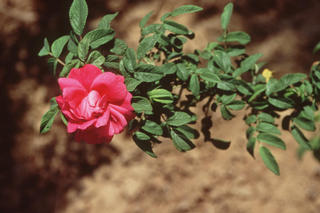Rosa rugosa
Contents
Nomenclature
Other Names:
Historical Use of Rosa rugosa
Rosa rugosa in Traditional Chinese Medicine
Background
Chinese Name (pinyin): Meiguihua
Chinese Name :
Common Name :Rose
Specific Name : Flos rosae rugosae
Scientific Name:
Collection : The drug is collected in batches before flowering in late spring and early summer and dried in time at a low temperature.
Description : Nearly hemispherical or irregular massed, 1 - 2.5cm in diameter. Receptacle hemispherical, accreted with calyx at the base, calyx 5, lanceolate, yellowish green or brownish green, pubescent. Petals frequently crumpled, broadly ovate when unfolded, imbricated, purplish red, sometimes yellowish brown, stamens numerous, yellowish brown. Texture light And fragile, odor strongly aromatic, taste slightly bitter and astringent.
Identification : Surface view of calyx, non-glandular hairs densely covered, unicellular, frequently curve, 136 - 680µm long with thickened and lignified walls, glandular hairs with a multicellular head, oblate, 64 - 180µm in diameter and a multiseriated stalk, 50 - 340µm long, sometimes showing unicellular branches at the base. Cluster of calcium oxalate 9 - 25µm in diameter.
Processing :
Action : To relieve stagnation of qi, regulate blood circulation, and to arrest pain.
Indication : epigastric pain, anorexia, nausea and vomiting caused by stagnated qi; menstrual disorders; traumatic pain
Precautions :
Dosage : 1.5 to 6 g.
Storage : Preserve in well closed containers, protected from moisture, stored in a cool and dry place.
Nomenclature
Other Names:
Historical Use of Rosa rugosa
Rosa rugosa in Traditional Chinese Medicine
Background
Chinese Name (pinyin): Meiguihua
Chinese Name :
Common Name :Rose
Specific Name : Flos rosae rugosae
Scientific Name:
Collection : The drug is collected in batches before flowering in late spring and early summer and dried in time at a low temperature.
Description : Nearly hemispherical or irregular massed, 1 - 2.5cm in diameter. Receptacle hemispherical, accreted with calyx at the base, calyx 5, lanceolate, yellowish green or brownish green, pubescent. Petals frequently crumpled, broadly ovate when unfolded, imbricated, purplish red, sometimes yellowish brown, stamens numerous, yellowish brown. Texture light And fragile, odor strongly aromatic, taste slightly bitter and astringent.
Identification : Surface view of calyx, non-glandular hairs densely covered, unicellular, frequently curve, 136 - 680µm long with thickened and lignified walls, glandular hairs with a multicellular head, oblate, 64 - 180µm in diameter and a multiseriated stalk, 50 - 340µm long, sometimes showing unicellular branches at the base. Cluster of calcium oxalate 9 - 25µm in diameter.
Processing :
Action : To relieve stagnation of qi, regulate blood circulation, and to arrest pain.
Indication : epigastric pain, anorexia, nausea and vomiting caused by stagnated qi; menstrual disorders; traumatic pain
Precautions :
Dosage : 1.5 to 6 g.
Storage : Preserve in well closed containers, protected from moisture, stored in a cool and dry place.
Nomenclature
Other Names:
Historical Use of Rosa rugosa
Rosa rugosa in Traditional Chinese Medicine
Background
Chinese Name (pinyin): Meiguihua
Chinese Name :
Common Name :Rose
Specific Name : Flos rosae rugosae
Scientific Name:
Collection : The drug is collected in batches before flowering in late spring and early summer and dried in time at a low temperature.
Description : Nearly hemispherical or irregular massed, 1 - 2.5cm in diameter. Receptacle hemispherical, accreted with calyx at the base, calyx 5, lanceolate, yellowish green or brownish green, pubescent. Petals frequently crumpled, broadly ovate when unfolded, imbricated, purplish red, sometimes yellowish brown, stamens numerous, yellowish brown. Texture light And fragile, odor strongly aromatic, taste slightly bitter and astringent.
Identification : Surface view of calyx, non-glandular hairs densely covered, unicellular, frequently curve, 136 - 680µm long with thickened and lignified walls, glandular hairs with a multicellular head, oblate, 64 - 180µm in diameter and a multiseriated stalk, 50 - 340µm long, sometimes showing unicellular branches at the base. Cluster of calcium oxalate 9 - 25µm in diameter.
Processing :
Action : To relieve stagnation of qi, regulate blood circulation, and to arrest pain.
Indication : epigastric pain, anorexia, nausea and vomiting caused by stagnated qi; menstrual disorders; traumatic pain
Precautions :
Dosage : 1.5 to 6 g.
Storage : Preserve in well closed containers, protected from moisture, stored in a cool and dry place.
Synonymns for Rosa rugosa
Patent Medicines and Medicines with Multiple Ingredients that include Rosa rugosa
Pharmaceutical Information
Chemical Constituents
Evidence or the Use of Rosa rugosa in the Treatment of Epilepesy
Basic Science
Animal Studies
Cohort, Case-Control and Non-Randomized Trials
Randomized Controlled Trials
Meta-Analysis
1st Five Results: pubmed search
Yanli Bian, Jinju Pan, Deliang Gao, Yizhi Feng, Bingjie Zhang, Le Song, Lei Wang, Xingang Ma, Lin Liang
Bioactive metabolite profiles and quality of Rosa rugosa during its growing and flower-drying process.
Food Chem: 2024, 450;139388
[PubMed:38640529]
[WorldCat.org]
[DOI]
(I a)
Guo Wei, Yudie Chen, Jianwen Wang, Liguo Feng
##Title##
PeerJ: 2024, 12;e16929
[PubMed:38435988]
[WorldCat.org]
[DOI]
(I e)
Merhaba Abla, Yueyue Cai, Lu Gao, Jingsong Wu, Lixin Yang
##Title##
Heliyon: 2024, 10(5);e25982
[PubMed:38434381]
[WorldCat.org]
[DOI]
(P e)
Yi Zhao, Linan Zhao, Tao Wang, Zhenghao Liu, Suyuan Tang, Hongxia Huang, Li Wu, Youzhi Sun
The Herbal Combination Shu Gan Jie Yu Regulates the SNCG/ER-a/AKT-ERK Pathway in DMBA-Induced Breast Cancer and Breast Cancer Cell Lines Based on RNA-Seq and IPA Analysis.
Integr Cancer Ther: 2024, 23;15347354241233258
[PubMed:38369762]
[WorldCat.org]
[DOI]
(I p)
C Peng, P W Crous, N Jiang, X L Fan, Y M Liang, C M Tian
##Title##
Persoonia: 2022, 49;201-260
[PubMed:38234377]
[WorldCat.org]
[DOI]
(P p)
